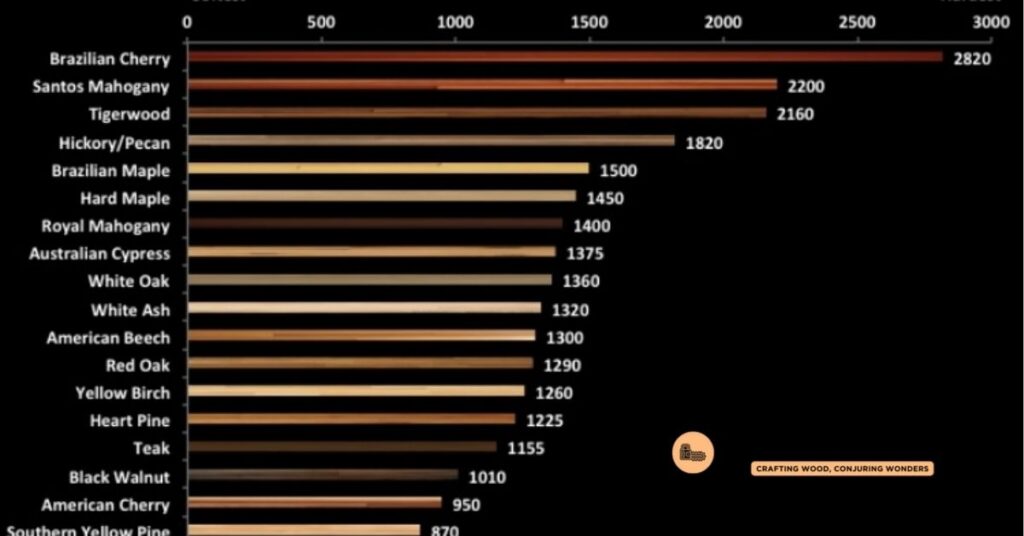Choosing the right wood for your project can feel overwhelming, especially when durability is a top priority. How do you know if a wood species can handle daily wear and tear or resist dents and scratches? That’s where the Janka hardness scale comes in—a trusted tool that takes the guesswork out of selecting the perfect wood.
The Janka scale doesn’t just measure hardness; it helps you make smarter decisions. Whether you’re planning a stunning hardwood floor or crafting durable furniture, understanding these wood ratings ensures you’ll pick a material that lasts. Ready to discover how this scale works and which woods rank the highest? Let’s jump into the details that’ll give you confidence in every choice you make.
What Is The Janka Hardness Scale?

The Janka hardness scale measures a wood species’ resistance to wear and indentation. It quantifies the force needed to embed a 0.444-inch steel ball halfway into the wood’s surface. Developed as a standard, it provides a clear metric for comparing wood durability.
Wood species with higher Janka ratings, like Brazilian Walnut or Hickory, offer exceptional resistance to dents. Lower-rated woods, such as Pine or Poplar, are softer and more prone to scratches. This numerical rating helps you assess wood suitability for exact applications.
Flooring and furniture industries frequently use the Janka scale to evaluate wood performance. For example, maple and oak are common choices for high-traffic areas due to their mid-to-high hardness ratings. By referencing these values, you can identify woods that align with durability and aesthetic needs.
How The Janka Hardness Test Works

The Janka hardness test determines how hard or soft a wood species is by measuring resistance to penetration. This standardized test provides numerical ratings, helping you compare wood durability for various applications.
Importance Of The Janka Test
Choosing wood based on Janka ratings ensures materials will endure exact conditions. High-traffic areas, like floors and stairs, benefit from harder woods, while softer species suit decorative pieces or low-use furniture. For example, Brazilian Walnut, rated at 3,680 pounds-force, withstands wear better than Pine, which measures 380. These ratings simplify wood selection by matching durability requirements.
Testing Process And Standards
The test presses a 0.444-inch steel ball into the wood until it’s embedded halfway. The force in pounds required to reach this point determines the rating. Accurate results depend on standardized conditions, including wood moisture content at 12%. Testing applies uniformly to all species, from hardwoods like Hickory to softer woods like Poplar. Hardwood flooring and furniture industries rely on these consistent methods to evaluate material performance.
Complete Wood Ratings Explained
The Janka hardness scale provides a reliable comparison of different wood species for both durability and wear resistance. This section breaks down softwoods, hardwoods, and exotic species based on their ratings to help you make informed decisions.
Softwoods Compared
Softwoods generally feature lower Janka ratings, making them less resistant to wear and dents. For instance, Pine measures between 380 and 870 pounds-force (lbf), depending on the variety, making it more prone to scratches. Poplar, often categorized alongside softer woods, has a Janka rating of approximately 540 lbf. These woods are better for low-traffic or decorative purposes due to their reduced hardness. Cedar remains similarly soft, scoring around 350 to 900 lbf, depending on the species, which limits its application to areas with minimal daily use.
Hardwoods Compared
Hardwoods, as a category, exhibit significantly higher Janka ratings than softwoods. Oak, one of the most commonly used hardwoods, scores between 1,200 and 1,360 lbf, offering balanced durability for flooring and furniture in high-traffic zones. Maple falls within a comparable range, with ratings from 950 to 1,450 lbf, based on its type, making it versatile for floors and heavily-used items. Hickory outperforms many other domestic woods with an impressive rating of about 1,820 lbf, ideal for heavy-use environments. Walnut, though slightly lower at 1,010 lbf, is preferred for its blend of durability and aesthetic appeal.
Exotic Woods Ratings
Exotic wood species often dominate the upper end of the Janka scale thanks to their exceptional hardness. Brazilian Walnut, also known as Ipe, is among the toughest, boasting a rating around 3,680 lbf, making it highly resistant to dents and scratches. Cumaru, another durable option, closely follows with a rating of approximately 3,340 lbf. Tigerwood, while slightly softer, still offers impressive resistance with a Janka hardness of 2,160 lbf, making it suitable for luxurious and long-lasting flooring. Teak, revered for its durability and natural moisture resistance, measures roughly 1,000 to 1,150 lbf, positioning it as a slightly softer but highly dependable exotic choice.
Applications Of Janka Hardness Scale

The Janka hardness scale provides essential insights when selecting wood for various purposes. It helps align wood type with performance expectations across multiple applications.
Choosing Flooring
Hardwood flooring demands a balance of beauty and durability. Mid-to-high Janka ratings, like those of Oak (1,200-1,360 lbf) or Hickory (1,820 lbf), suit high-traffic areas and household environments. These hardwoods resist wear, reducing dents and scratches from furniture or heavy foot traffic. For regions with less foot activity, woods with moderate ratings, such as Cherry (950 lbf), can work well. Higher-rated options, including Brazilian Walnut (3,680 lbf), excel in commercial settings or homes needing extreme durability.
Furniture Durability
Furniture suitability depends on exact usage and wood hardness. Denser woods with higher Janka scores, like Maple (1,450 lbf) or Cumaru (3,340 lbf), ensure longevity for frequently used furniture like dining tables and bed frames. Softer woods such as Poplar (540 lbf) are better for decorative items or low-use furniture, where a lightweight, workable material is favorable. Using the Janka scale helps balance cost, durability, and aesthetics according to usage intensity.
Woodworking Considerations
Craftsmanship benefits from choosing the right wood hardness for a project. Softer woods, such as Pine (380-870 lbf), allow easier cutting and shaping, making them ideal for intricate designs. Harder woods like Tigerwood (2,160 lbf) or Hickory require specialized tools but offer superior durability for outdoor or load-bearing structures. Understanding Janka scores guides your selection to match woodworking goals and equipment capabilities.
Factors Influencing Janka Ratings

Janka ratings depend on various factors that affect a wood’s resistance to wear and indentation. Understanding these aspects helps you choose wood effectively for exact applications.
Wood Grain Direction
Grain direction significantly impacts Janka test results due to variations in wood structure. Testing perpendicular to the grain often produces the highest hardness values, as the dense fibers resist penetration. Parallel grain testing can show lower resistance, making the same wood appear softer. This distinction matters because real-industry conditions expose wood to forces from different angles.
Moisture Content
The amount of moisture in wood influences its hardness levels. Higher moisture softens the wood fibers, reducing Janka ratings, while lower moisture ensures tighter fibers, improving hardness. Ideal test conditions use wood with about 12% moisture content to offer consistent results. For instance, Brazilian Walnut may exhibit slight variations in ratings if moisture fluctuates significantly.
Wood Species Variations
Species naturally differ in density and hardness based on their growth traits. Hardwood species like Hickory or Brazilian Walnut generally exhibit denser structures, resulting in higher Janka ratings, such as 1,820 lbf and 3,680 lbf respectively. Softer woods, like Pine and Poplar, score much lower, around 380-540 lbf. Exact species variations ensure that not all woods within a category behave identically under pressure.
Conclusion
The Janka hardness scale is an invaluable resource when you’re choosing wood for any project requiring durability and resilience. By understanding how wood species perform under pressure, you can confidently select materials that align with your needs, whether it’s for high-traffic flooring, sturdy furniture, or decorative pieces.
With this knowledge, you’re equipped to balance performance, aesthetics, and practicality, ensuring your projects stand the test of time. Let the Janka scale guide your decisions and help you achieve the perfect blend of strength and style for your next woodworking try.









